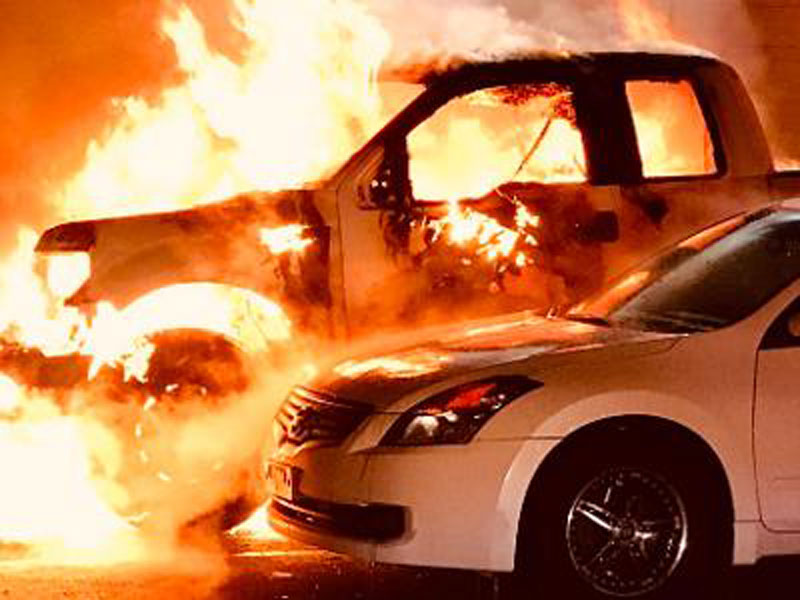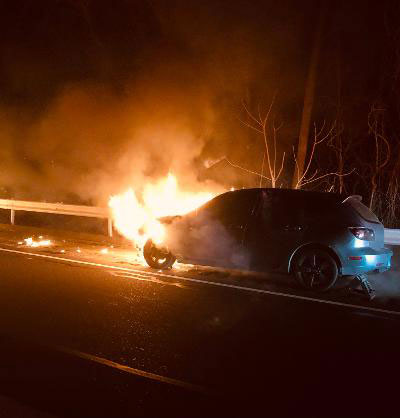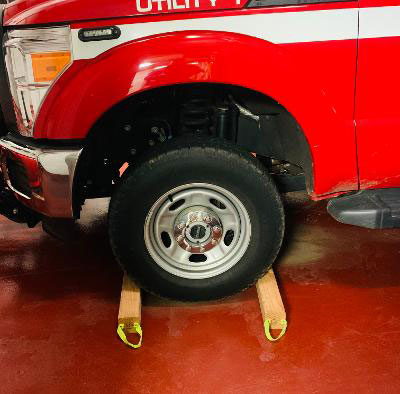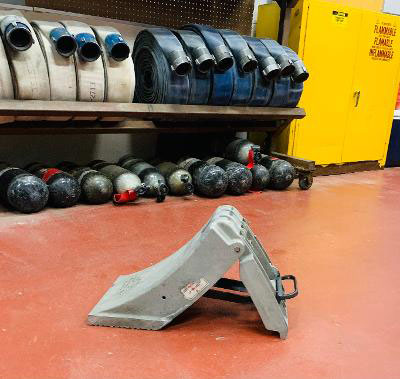While sitting at my desk last tour, finalizing some end-of-day paperwork, the tones dropped and a two-apparatus response was dispatched for a reported car fire. Originally, the location was said to be southbound of a limited access highway, but en route dispatch rerouted both companies to the northbound side. Knowing this highway fairly well, we were aware that this particular section is slightly elevated. We arrived on scene to find a four-door, passenger type vehicle with a fire in the engine compartment. We were presented with a scene known well to most firefighters. Most firefighters responding to an incident such as this would probably think to themselves: “It’s a car fire. No big deal.” I shared those same sentiments as I arrived on scene.

We positioned the fire apparatus, gave a quick size-up, and had the backseat firefighter stretch a line. While walking up to the vehicle, hiking my pack up on my hips, I heard the firefighter stretching the line yell: “Its rolling!” I looked up and was presented with the image of a glowing vehicle against the night sky rolling toward us.
RELATED FIREFIGHTER TRAINING
Being already greater than halfway to the vehicle, I figured my best option was to physically put my hands on the rear bumper of the vehicle to stop it from rolling. Some may say: “That’s an utterly unsafe action, how could someone even think about doing that?” It was a judgement call. Situationally and in all reality, it wasn’t advancing towards us at a high rate of speed, and it was a small-sized sedan. I’m not advocating to stand in front of a car coming at someone 20 miles an hour, fully involved from bumper to bumper. I did not anticipate a difficult stop and it wasn’t. While physically applying pressure, my chauffeur grabbed the apparatus wheel chock and placed it under the rear driver side tire.
With luck obviously not being on our side that night, to make things worse, the rear tire came to rest directly on top of the uncharged hoseline. Working together, we pushed the vehicle a few feet forward, freed the hose from underneath the tire, re-chocked the wheel, and then were able to proceed with conventional firefighting operations to extinguish the fire. After the incident was over, members discussed it and agreed the vehicle had rolled between 20-30 feet.


When responding to vehicle fires, motor vehicle accidents, or simply a medical emergency that happens to be taking place inside of a vehicle, one of the hazards which must be mitigated first and foremost is to ensure the vehicle is in park, the emergency brake engaged, and the keys taken out of the ignition. This is to ensure a safe working area while operations are underway.
Some newer firefighters may not be aware of how to operate or secure a manual type transmission vehicle. This is by no means any fault of their own, it’s just that manual type vehicles have faded out over time and they aren’t as common as they were years ago. Manual transmissions are also referred to as standards or standard transmission. A manual transmission does not have a “park gear.” To park the vehicle, the emergency brake must be pulled and the car left in gear (it’s said first gear or reverse gear are the most advisable). Leaving the car “in gear” ensures greater resistance if the emergency brake were to fail or if the emergency brake was inadvertently disengaged.
When dealing with the more familiar automatic transmission, we simply need to place the car in park. It is still advisable to engage the emergency brake when parking automatics. When operating at incidents, it’s also extremely important to ensure the keys are taken out of the ignition, making sure the vehicle is off. This ensures the vehicle won’t engage/start driving and will stop gasoline and other fluids from pumping, thereby making the overall vehicle safer to work with and around. It’s been taught to place the keys on the roof of the vehicle once removed. This provides for an accessible place for the keys if needed. If the vehicle needs to be turned back on, the tow truck/wrecker operator needs access, or whatever the reason, they are right there at eye level for all to see. Another caveat to this is to prevent an unassuming firefighter from inadvertently placing the keys in their turnout pockets out of habit, causing an unnecessary hunt for them after the incident is over (we’ve seen it happen before).

These safety measures for securing the vehicle work great for some motor vehicle accidents and medical emergencies, but is obviously not as easy when dealing with vehicles that are on fire. Most times we don’t have this luxury of “Checking off these boxes,” as the car will be charged with smoke from an engine compartment fire or be completely inaccessible due to the passenger compartment being fully involved. This leaves us with few options to secure the vehicle. The best option and easiest to deploy is to simply chock the wheels of the vehicle. Most fire schools, academies, and classes teach to take simple 4×4 wood chocks and place them in front of or behind the wheel, depending on if the vehicle is positioned up or downhill. Another option, depending on where your cribbing is located, is to use the apparatus wheel chock as described earlier. After getting the one chock down, when time permits, it is advisable to chock the other side of the tire/wheel if you are on relatively flat ground.

When people are driving down an interstate, a major route, or simply a side street, the checklist of securing the vehicle when it is actively on fire is not as easy as it may sound. These people are most likely facing the biggest emergency they have ever faced in their entire lives. The simple act of getting themselves and their family members out of and away from the vehicle is challenging enough, let alone remembering to engage the parking or emergency brake and turning off the vehicle. When arriving on scene of a vehicle fire, assume none of these actions have been taken. Until proven otherwise, assume the vehicle is still running, is a manual transmission, is in neutral, and the emergency brake has not been engaged.
- Ray Downey: CHOCKS, BLOCKS, AND CRIBBING
- Training Minutes Revisited: Quick Wheel Chock for Stabilization
Revisiting the incident from the other evening, after the fire was extinguished and overhauled, we had a chance to figure out why the car started to roll on us. The vehicle ended up having a manual transmission, was left in neutral, and the emergency brake was never engaged. That said, even when drivers do remember to engage the emergency brake, if the vehicle is well involved upon arrival there is a chance the cable that activates the emergency braking system could burn through and fail completely. Thus, arriving and finding a vehicle on fire rolling towards you is thus in the realm of possibility. I’m certain we can all agree most companies within our fire service are quite diligent in securing the vehicle while performing operations at a vehicle fire. Whether earlier or later, most companies always remember to chock/secure the vehicle at some point during the incident. May we never allow near misses, mishaps or mistakes to happen in vain. We must learn from our experiences and become better firefighters through them.
For me personally, besides size-up, scene safety, checking for victims in/around the vehicle, assisting with stretching the line, etc,, there is yet another benchmark I will be adding to my first-arriving checklist at a vehicle fire. From the ashes of this small vehicle fire comes a lesson learned and a fire officer who will try to walk up with a wheel chock in hand when taking arrival at his next “regular” vehicle fire.

ADAM J. HANSEN is a captain with the Milford (CT) Fire Department, where he has worked since 2006. He began his career as a volunteer in Branford, Connecticut, in 1999. Hansen has a bachelor’s degree in fire science (fire administration) and a minor in criminal justice from the University of New Haven. He is a nationally registered paramedic and is a state-certified fire service instructor 2, fire officer 2, incident safety officer, pump operator, and aerial operator. He is certified in rescue operations: trench.

